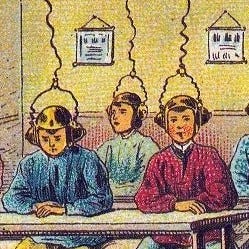This week the focus was on an old Futures friend, the Cynefin framework. I discussed Cynefin pretty extensively during Systems Thinking, so I’ll refer you back to that article for the basics (it’s pretty good!) and just add a couple of new ideas here.

First, observe that, despite Snowden’s attempts to soften the diagram, it’s essentially a 2x2 grid, and so it’s in danger of being compared to the thousands of other 2x2s that have been created over the last 60 years of business consulting1. This includes the Rumsfeld matrix2, Stirling’s matrix, the Goals and Methods matrix, and (if you can stomach a 3x3 broken down into 5 regions) the Stacey Matrix.
Next, though Cynefin doesn’t contain a theory about where change comes from, it is a set of assertions about how change happens, and can be compared to other theories of change. For example, Polybius’s theory of political regime change aligns well with a counter-clockwise trip through Cynefin: monarchies, where one person rules society and things are simple, become tyrannical over time and are replaced by a coalition of nobles, forming a more complicated oligarchy with competing interests, becoming decadent and being overthrown in favor of the complexities of democracy, which lasts until people lose the spirit of equality3 (broadly similar to Ibn Khaldun’s asabiyya), descending into chaos until a leader emerges to unify by force again. The idea of The Fourth Turning is similar: a clear organizing concept takes root and creates a High period, which is complicated by an Awakening of alternative values, eventually leading to an Unraveling as cause and effect stop becoming clear, and finally landing in a chaotic Crisis that must be solved to start the next cycle.
One way to read these is as a story about social entropy: the natural order of things, absent a significant, willful investment of energy, is for organizing ideas to degrade over time and require increasing complexity to manage, until finally all direction is lost and the resulting chaos creates enough will for previously unthinkable change. This resembles but doesn’t quite match the view of Martin Berg, who charts the path4 of increasing order over time through the exertion of effort (basically, intentionally working backwards against the natural order), but who also doesn’t see much path from chaos directly to clear systems.
Changing Minds
The other topic this week was about how humans actually change their minds. For theories of change that center ideas more than material circumstance, such as those of Weber, Polak, and even JT Mudge, this is central: if changes in society come from changes in ideas, then understanding the process by which minds change is the equivalent of seeing the code in the Matrix. The most critical realization is that making a logical argument or calling people stupid doesn’t have much effect5; rather, factual beliefs are the visible manifestation of processes that include identity formation/protection, group affiliation, and emotional experiences.
There are different ways people have devised to reverse-engineer this process. For specific beliefs you want to change, check out the last two pages of this discussion guide from David McRaney’s How Minds Change, which is essentially a way to use empathy to get someone to lay out the whole map of their path to the belief so you can have them argue against it themselves6. This is similar to the business-world-ubiquitous Crucial Conversations approach, which takes a more bilateral approach: creating space for high-stakes conversations by contributing facts/observations, explaining the story you tell yourself to make sense of the facts, sharing your feelings about the story, deriving a reasonable plan of action given the story and feelings, and helping the other person do the same, by working them through the steps backwards if needed. Then reasonable discussions can be had about the facts and actions, new information and ideas can be shared, and mutually satisfactory plans can be developed.
I’m not convinced this is a natural fit, because Cynefin is much more about the adjacencies and trajectories than about encoding information in the horizontal and vertical positions: for example, many systems will operate in a clockwise direction, simplifying processes and markets until they become so brittle they break; for example, think about the normalization of just-in-time inventory, which became more and more a clear, solved problem, until COVID and then Ever Given threw the whole system into chaos. I think that’s one of the reasons the square is always squishy and there’s a realm of “confusion” in the middle.
As the saying goes:
Reports that say that something hasn't happened are always interesting to me, because as we know, there are known knowns; there are things we know we know. We also know there are known unknowns; that is to say we know there are some things we do not know. But there are also unknown unknowns—the ones we don't know we don't know.
Note that he never mentioned the idea of “unknown knowns”, which are a critical part of making this a 2x2 but don’t make a lot of sense. I have seen multiple people try to rationalize this space — the truths we bury from our subconscious mind, the patterns we have available in data and haven’t yet decoded, etc — but I’m deeply unconvinced. I think the idea is closer to the (one-dimensional) Plain, Vincible, and Invincible Ignorance of Postnormal Times.
Polybius’s archetypal story here is the kind of thing people who are sloppy with modern parallels would salivate over:
But when a new generation arises and the democracy falls into the hands of the grandchildren of its founders, they have become so accustomed to freedom and equality that they no longer value them, and begin to aim at pre-eminence; and it is chiefly those of ample fortune who fall into this error. So when they begin to lust for power and cannot attain it through themselves or their own good qualities, they ruin their estates, tempting and corrupting the people in every possible way. And hence when by their foolish thirst for reputation they have created among the masses an appetite for gifts and the habit of receiving them, democracy in its turn is abolished and changes into a rule of force and violence. For the people, having grown accustomed to feed at the expense of others and to depend for their livelihood on the property of others, as soon as they find a leader who is enterprising but is excluded from the houses of office by his penury, institute the rule of violence; and now uniting their forces massacre, banish, and plunder, until they degenerate again into perfect savages and find once more a master and monarch.
Adorably so, and with entropy explicitly added as a dimension (negative height):
Ruling out, respectively, newspaper editorial pages and YouTube comments sections as persuasive media.
But, you know, don’t be manipulative…





